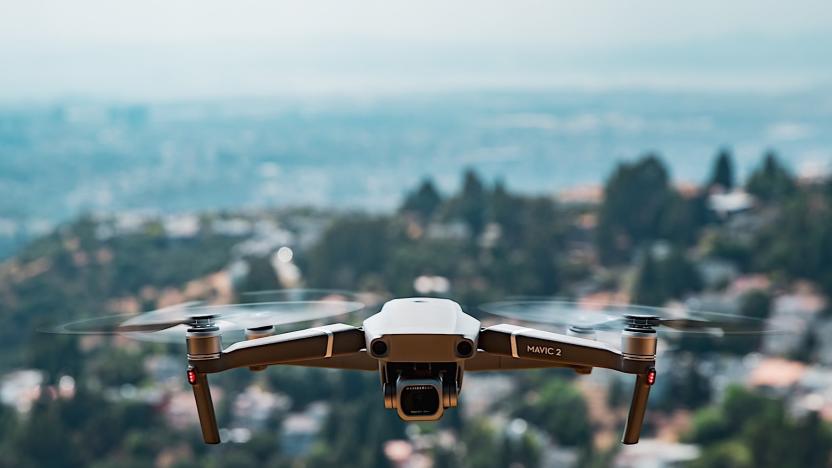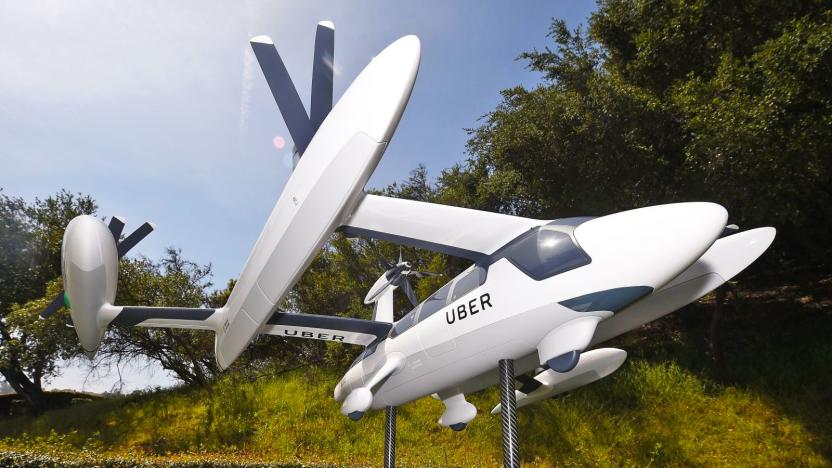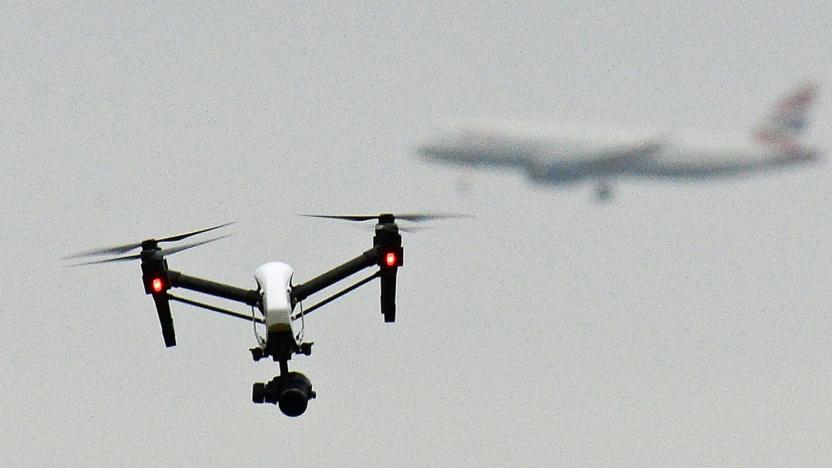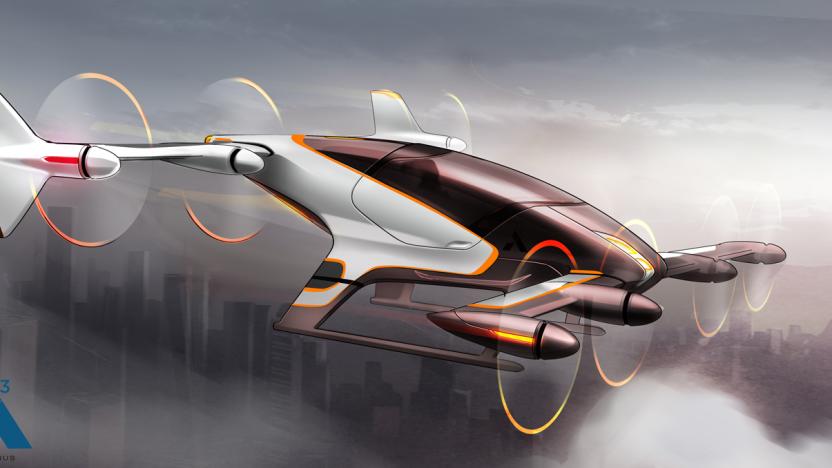AirTrafficControl
Latest

DJI drones will detect and warn of airplanes and helicopters
DJI has announced that all its consumer drones over 250 grams will use "AirSense" tech to help operators see and avoid airplanes and helicopters. They'll be equipped with so-called ADS-B sensors already installed in many aircraft and air traffic control (ATC) towers. Drone pilots will be able to see air traffic on their controllers and take evasive action if the system will warns of any potential collisions. "ADS-B was designed for airplanes and helicopters, but already there are more drones in the sky than any of them," said DJI VP of policy Brendan Schulman.

Uber doubles down on partnership with NASA for flying taxi service
Uber had announced last fall that its flying taxi project Elevate would be getting help with its software from NASA. Naturally, you can't do this with just any deal, and the pair signed a Space Act Agreement to make an air traffic control system to handle its aerial taxi fleet. Both have doubled down on their partnership with a second compact wherein the space agency will take Uber's plans and simulate how they'll work in Texas airspace.

Air traffic controllers may get a break from non-stop drone reports
Air traffic controllers have it bad enough managing full-size aircraft, but they face an extra headache when you throw drones in the mix. You see, controllers get calls when drone pilots want approval to fly within 5 miles of an airport -- and with an average of 250 reported close encounters per month, it's clear that some aren't even bothering with the formalities. The FAA has clearly had enough of this, as it recently made an emergency request to bypass the usual regulations and use an automate system to approve drone flights in restricted airspace. Instead of waiting 2-3 months for clearance (or calling in at the last possible moment), you could get the A-OK within 5 minutes.

FAA says a buggy software update grounded flights
Ever got a bad smartphone update? Now imagine that your phone controls air traffic on the Eastern seaboard, and you have some idea what happened to flights on Saturday. The FAA said that a software update that was supposed to help controllers see frequently used info at a radar facility ended up bringing down the overall system. That caused the cancellation of hundreds of flights in Baltimore and Washington, DC, reducing capacity up to 28 percent. The agency said everything's fine now that it's disabled the new function, and it's working with Lockheed Martin to figure out why the bug wasn't caught in testing. Meanwhile, you can now factor software glitches, hacking and bad routers into your flight plans.

New FAA system can track twice as many flights at once
Whoever said "it's the journey, not the destination" obviously lived in a time before air travel. But maybe, just maybe, the Department of Transportation's implementation of the En Route Automation Modernization (ERAM), the "backbone" of the NextGen air-traffic system, could change how we feel about getting on a flight. There are a few things making up ERAM: performance based navigation, automatic dependent surveillance-broadcast (ADS-B) and data comm.

Internet.org targets efficiency and cost reduction to connect the next 5 billion
If Internet.org ever hopes to be successful with its goal of bringing affordable internet to the next 5 billion people, the cost of delivery will need to be much cheaper than it is today. Today, members of the coalition -- which includes Facebook, Qualcomm, Ericsson and others -- released a substantial 70-page white paper that outlines some of the initial steps that are on the drawing board. According to the group's estimates, data delivery is currently 100 times too expensive to execute the vision of Internet.org, but all of that could change within the next decade. To accomplish this, Internet.org is seeking ways to bring a tenfold improvement to the cost of delivering data, along with apps that are 10 times more efficient. For Facebook's part, it highlights technologies such as HipHop for PHP and the HipHop virtual machine, which allows its existing servers to accommodate 500 percent more traffic than before, and its Air Traffic Control system, which allows it to simulate different mobile networks and congestion systems around the world. Similarly, Facebook is looking to compression technologies such as WebP -- currently in use on its Android app -- to replace image formats such as PNG and JPEG, which alone could reduce network traffic by 20%. Another challenge is looming, however, as Qualcomm estimates that the demand for data will double each year over the next 10 years, ultimately increasing 1000 fold over where it is today. To meet that demand, it's lobbying for a substantial spectrum reallocation, along with technologies such as carrier aggregation, LTE-Broadcast and LTE Direct. Combine this with more unconventional approaches that it'll reveal at a later date, and you begin to appreciate the massive undertaking that lies ahead for the partners of Internet.org.

Congress passes bill giving the FAA $11 billion to get off radar, onto GPS
It took awhile, and the price tag is quite a bit steeper than previously thought (shocking, right?), but the FAA is finally getting the funding it needs to bring the nation's air traffic control system up to date. Congress just passed the bill to make it happen, allotting $11 billion to the FAA to upgrade the nation's 35 busiest airports air traffic controls from radar to GPS. The deadline for the conversion is June 2015, and when complete, it'll allow for more precise positioning of aircraft -- GPS pings for the planes' locations every second, while radar updates their locations every 6 to 12 seconds. With such technology enabled, airplanes will be able to take-off and land more closely together while utilizing steeper descents than is currently possible to conserve fuel. So, now that we've got the new traffic control system to improve airline punctuality, we just need the FAA and the FCC to team up and eliminate the "Terrible 10,000 feet" and flying might actually be fun.

Eizo industrial monitor does 4K resolution at 36-inches, start saving now
Looking for a display that can do justice to all that 4K footage you've been shooting on your Red One or Arri Alexa lately? Okay, perhaps not. But if you were, then the DuraVision FDH3601 from Eizo Nanao could handle it easily with 4096 x 2160 pixels spread over 36.4-inches of LED-backlit real estate. It comes with another big number too: a price tag of ¥2.88 million ($36,000), which gently hints at the fact that this beast is primarily aimed at specialist industrial applications. Eizo claims it's perfect for air traffic control, where staff can make full use of specs like "Digital Uniformity Correction" circuitry to compensate for uneven color or brightness, motion sensors to power the monitor on or off as needed, and a stand that can be minutely adjusted to get the perfect angle. Suddenly, despite the heavy burden of responsibility and the fact that you have to keep your phone switched off all the time, that career choice seems almost worth it.

GPS-based air traffic control system to go live by 2020
If you've ever watched an investigative journalism show that exposes things you didn't know you had to worry about, there's a good chance you've seen footage of the archaic green-screens in use at airport towers across the country paired with shocking headlines like "Hidden Airport Menace" or "Glidepath to Danger." Plans to replace that tech are finally in motion, with the FAA indicating its new air traffic control system will go into effect by 2020, possibly as early as 2015. This system requires that any aircraft flying within commercial airspace must have a GPS-equipped navigation system -- and we don't mean a TomTom stuck on the windshield. These systems will cost between $5,000 and $10,000 for small planes and are able to beam information to ground control stations that will no longer have to rely exclusively on radar. The plan could cost the FAA alone roughly $4 billion, giving bored local news personalities something else to sensationalize.

Majesco's Air Traffic Chaos to pull up to DS terminal this summer
Majesco, obviously annoyed with being told to put away approved portable electronic devices until after take off, has announced that its next game for the Nintendo DS will put controlling air traffic in players' hands. The aptly titled Air Traffic Chaos will allow players to direct numerous aircraft takeoffs and landings as an air traffic controller. The game marks the second DS release from Japanese studio Sonic Powered, a primarily mobile phone game developer behind From the Abyss for the DS and MiniCopter for the Wii.Details are few and far between, though Majesco notes that the game will include Rumble Pack support and describes the gameplay as "frantic" as players "safely manage takeoffs, gate assignments and landings for all incoming and outgoing airport traffic for 14 different airlines in varying weather conditions." While we're sure safety is the goal, the urge to play chicken in the not-so-friendly skies might just be too much to resist when Air Traffic Chaos takes off this summer.









